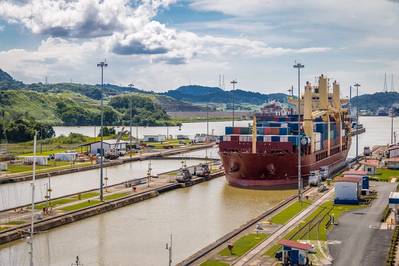Panama Canal to Become Carbon Neutral by 2030
The Panama Canal has set out to decarbonize its operations, with a target to become carbon neutral by 2030.
“We at the Panama Canal are committed to sustainability, and therefore are laying the foundation, creating the tools and identifying the changes needed to achieve efficiencies that will allow us as an organization to reach carbon neutrality. This is a fundamental strategy for the waterway's long-term operation and sustainability,” said Panama Canal Administrator Ricaurte Vásquez Morales. “This process will build on our long-standing efforts to minimize our environmental impact, including encouraging customers to use clean fuels and reduce their carbon footprint.”
The waterway said it purchased four electric vehicles as part of a pilot program that will collect data to inform the migration of the Canal’s entire fleet away from fossil fuel dependence. Part of its strategic decarbonization plan also includes tugboats and launches that use alternative fuels, the substitution of electricity production processes in favor of photovoltaic plants, the use of hydraulic energy, and ensuring that all facilities and infrastructure projects are environmentally responsible and sustainable.
The Panama Canal is also pursuing ways to maximize its operational, and thus environmental efficiencies, whether by implementing water conservation measures or optimizing transits. Panama's Maritime Single Window (VUMPA) has improved the efficiency and carbon footprint of transshipment procedures by streamlining logistics paperwork for international customers passing through the country, saving up to 3,260 hours and over 300,000 paper forms each year.
The Panama Canal first began tracking its carbon footprint in 2013 to align its operations with the global objectives of reducing emissions to mitigate and adapt to climate change. Its plans to become carbon neutral were bolstered in 2017 with the launch of its Emissions Calculator, a tool that not only allows shipping lines to measure their greenhouse gas (GHG) emissions per route, but also strengthens the Canal’s analysis of the emissions produced by its own day-to-day operations.
On April 22, the Panama Canal joined the Declaration of the “50 First Carbon-Neutral Organizations”, an initiative led by Panama’s Ministry of Environment to integrate national efforts to accelerate measurable climate actions. As part of the national initiative, the Canal will develop an annual greenhouse gas inventory, as well as an action plan with measurable targets to reduce emissions. The Canal’s efforts will be factored into Panama’s National Determined Contribution (NDC), established by the United Nations Framework Convention on Climate Change (UNFCCC), following the Paris Agreement.
The Panama Canal’s efforts have since stretched beyond tracking to include initiatives aimed at helping and incentivizing shipping lines to minimize their environmental footprint. Through its Green Connection Environmental Recognition Program, the Canal recognizes customers who demonstrate excellent environmental stewardship, including the use of low-carbon fuels and environmentally conscious routes. As an enhancement to this program, the Panama Canal is currently analyzing taking into account in its dynamic pricing strategy the vessels' technology and its carbon footprint, which makes it more efficient during transit.
The Panama Canal also promotes the International Maritime Organization’s (IMO) efforts to minimize the environmental impact of the shipping industry, from the implementation of its IMO 2020 regulation to its nearby transit separation schemes and vessel speed reduction programs. By supporting the latter, for example, the Canal helps shipping lines reduce their risk of colliding with whales migrating near the waterway, while also lowering their GHG and pollutant gas emissions by an average of 75%, depending on the type, size, and fuel of each vessel.















